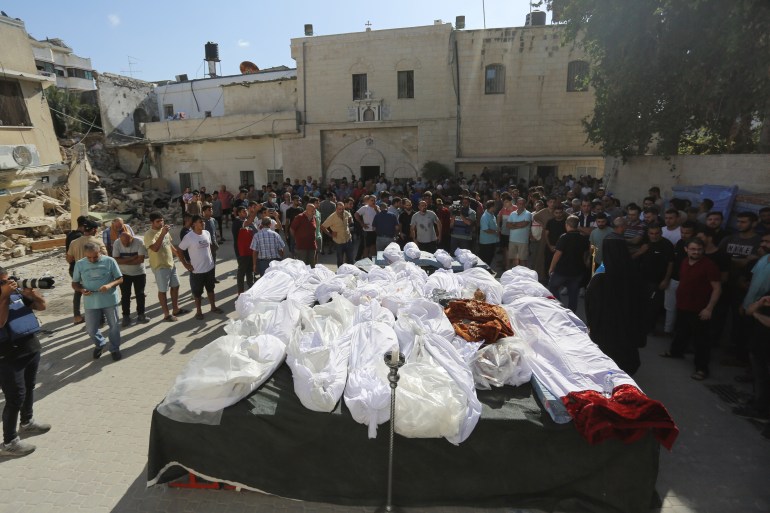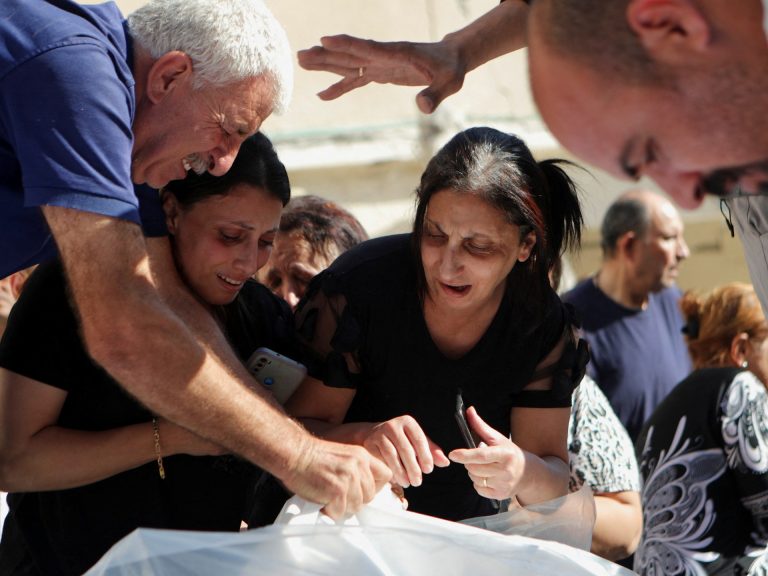Gaza strip – When Israeli bombs began to bombard the once-bustling streets of Gaza City, Diana Tarazi and her family fled to the Church of the Holy Family, the only Catholic place of worship in the Gaza Strip.
The 38-year-old Palestinian Christian, her husband and three children huddled alongside other worshipers and Muslim neighbors and friends, rocking their children into an exhausted sleep amid the noise of the bombings, whispering sweet nothings to each other. encouragement.
“Together we try to get through the war until it ends – and we survive it,” Tarazi told Al Jazeera.
Their sense of security was shattered on October 19, when Israel bombed the nearby church of Saint Porphyrius, the oldest in Gaza, killing at least 18 people. The Israeli military said in a statement that the church was not the target of the attack.
“The missile fell directly on it,” Tarazi said of the Greek Orthodox site. “We cannot believe that the Church was not their goal. »
Two days earlier, a blast at Al-Ahli Arab Hospital – an Anglican institution located a few blocks away – hundreds of dead and injured, according to Palestinian health authorities. Hamas blamed the explosion on an Israeli air raid, while Tel Aviv said it was caused by a malfunction in a rocket fired by Palestinian Islamic Jihad, an armed group based in Gaza.
Although Gaza City and adjacent refugee camps are surrounded by Israeli ground forces and air raids hit the area, Tarazi refuses to leave. “We do not accept the displacement of our country, our lands and our churches,” she said.
“I will only leave the church in the grave.”

” Endangered “
At least 10,569 Palestinians have been killed in Israeli attacks on Gaza since October 7.
It is estimated that only 800 to 1,000 Christians still live in Gaza, which constitutes the oldest Christian community around the world, dating back to the first century.
Mitri Raheb, an evangelical Lutheran pastor and founder of Dar al-Kalima University in Bethlehem, said it was conceivable that the current conflict marks the end of its long history in this strip of land.
“This community is threatened with extinction,” Raheb told Al Jazeera. “I’m not sure they will survive the Israeli bombings, and even if they do, I think many of them will want to emigrate. »
“We know that in this generation, Christianity will cease to exist in Gaza,” he added.
The broader region of historic Palestine is the birthplace of Christianity, as well as the scene of many events from the Old and New Testaments of the Bible.
By the fourth century, Gaza, located along a major trade route with access to a vibrant port and cosmopolitan city, became a major Christian missionary center. After 1948, when the State of Israel was established and 700,000 Palestinians were displaced from their homes in what became known as the Nakba, or “catastrophe”, more and more Palestinian Christians joined the coastal enclave community.
Estimates indicate that the number of Christians in Gaza has fallen in recent years from the 3,000 recorded in 2007, when Hamas took full control of the strip, triggering the Israeli blockade and accelerating the departure of Christians from the stricken enclave. by poverty.
West Bank attacks ‘quadrupled’
In the West Bank, Christians are more numerous, with more than 47,000 people living there, according to a 2017 census.
But there too, violence and persecution destabilized the community. “Attacks on clergy and churches have quadrupled this year compared to last year,” said Raheb, whose academic institution documents such events.
January 1, days after Israel was sworn in far-right government in the country’s history, two unidentified men broke into the Protestant cemetery of Mount Zion in Jerusalem and profane more than 30 graves, overturning cross-shaped tombstones and smashing them with stones.
On January 26, a crowd Israeli settlers attacked an Armenian bar in the Christian Quarter of Jerusalem’s Old City, shouting “Death to Arabs…Death to Christians.”
A few days later, Armenians leaving a memorial service in the Armenian Quarter were attacked by Israeli settlers armed with sticks. An Armenian man was pepper-sprayed as settlers scaled the walls of the Armenian convent, trying to tear down its flag, which bore a cross.
The attacks continued to intensify, alongside Israeli attempts to “silence any voices coming from Palestinians inside Israel,” Raheb said.
“They are Jewish settler terrorists, but the international community does not recognize them as such because it is part of the same colonial mentality,” he said, adding that he feared that the constant threat of violence would ends up driving Christianity out of the world. Holy Land.
“My children were disfigured, dead”
Back in Gaza, Ramez al-Souri tries to understand the deaths of his three children, Suhail, Majd and Julie, in the bombing of St. Porphyry Church.
“The building contained civilians that did not belong to them,” he said, referring to the Palestinian group Hamas, which launched the October 7 surprise attack in southern Israel that led to the Israeli bombings.
Al-Souri had hoped that his loved ones would be safe in a holy site, but even the sanctity of its premises could not protect his family from Israeli bombardment. The Israeli military is known to have also targeted United Nations schools housing displaced women and children, as well as hospitals, ambulances and humanitarian equipment.
“My three children came out disfigured by the effects of the missile and the shrapnel,” he said, still visibly in shock a few days later.
“I can’t believe I won’t talk or play with them again in my life.”


